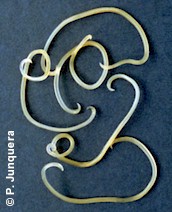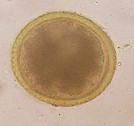Toxocara canis, also called the dog roundworm, is a parasitic nematode very common in dogs and other canids (e.g. foxes, coyotes, wolves). It can also infect humans.
Toxocara canis is not a bloodsucking worm. Depending on its developmental stage and location it feeds on body fluids of the host or on the intestinal content in its gut.
Toxocara canis is found worldwide. Eggs and larvae of Toxocara canis can survive for months and even years in the environment (see life cycle below). Therefore it must be assumed that most places regularly visited by dogs (gardens, parks, playgrounds, etc.) are more or less contaminated.

The disease caused by Toxocara canis is called toxocariasis. Toxocara cati, a related species infects cats; and Toxocara vitulorum infects cattle. All belong to a group of roundworms called ascarids (maw worms), together with other parasitic worms of veterinary importance, e.g. Ascaris suum and Toxascaris leonina.
Toxocara canis does not affect cattle, sheep, pigs, horses or poultry.
Are dogs infected with Toxocara canis contagious for humans?
- YES. If humans ingest eggs of Toxocara canis shed with the feces they can become infected as well. This can happen through direct or indirect contact with the droppings of infected dogs, but also indirectly through eggs in their hair coat. For additional information read the chapter on the life cycle below.
You can find additional information in this site on the general biology of parasitic worms and/or roundworms.
Final location of Toxocara canis
Predilection site of adult Toxocara canis is the small intestine, but migrating larvae can be found in the abdominal cavity and in several organs (lungs, eyes, heart, liver, etc.).
Anatomy of Toxocara canis
Adults of Toxocara canis have the typical slender shape of worms, with thinner head and tail. They are about 7 to 20 cm long and 2-3 mm wide, whereby females are larger than males. They have a whitish-yellowish color. In fact, they look very much like cooked spaghettis. The anterior end has two wing-like projections (alae). The head as three prominent lips armed with small teeth.
The worm's body is covered with a cuticle, which is flexible but rather tough. The worms have no external signs of segmentation. They have a tubular digestive system with two openings. They also have a nervous system but no excretory organs and no circulatory system, i.e. neither a heart nor blood vessels. The uteri may contain up to 30 million eggs. Males have simple chitinous spicules for attaching to the female during copulation.
The eggs are almost spherical, brownish, measure about 50x85 micrometers, have a thick wall with a rough surface, and contain a single cell.
Life cycle and biology of Toxocara canis

Toxocara canis has a direct life cycle, with dogs and other canids as final hosts, but particularly complex, because other mammals can act as transport hosts (also called paratenic hosts) where the worms do not complete development to adults, but can be rather harmful.
The eggs are shed with the dog's feces and once outside the host L2 larvae develop inside the eggs in 2 to 4 weeks depending on weather conditions. These eggs containing the L2 larvae are infective for dogs, but also for other mammals that act as transport hosts. A single infected dog or puppy can shed more than 100'000 eggs per gram of feces. By suitable conditions these eggs can survive and remain infective for months and even years in the soil.
In puppies up to 3 months of age, ingested eggs release the L2 larvae in the intestine. These larvae cross the gut's wall and migrate to the lungs through the portal vein and the liver. One in the lungs thy molt to L3 larvae, migrate to the trachea (windpipe) and further to the mouth (e.g. after coughing or sneezing). This migration takes about 10 days. From the mouth L3 larvae are ingested, reach the intestine, complete development to adult worms and start producing eggs, about 25 to 30 days after infection. Nursing bitches can become infected with these eggs when licking their puppies. In dogs older than 3 months the previously described cycle becomes less frequent.
In dogs older than 6 months the hatched L-2 larvae undertake a somatic migration that can lead them to numerous organs (liver, lungs, heart, brain, muscles, gut's wall, etc.) where they encyst and start a period of dormancy that can last for years. Part of these dormant larvae can migrate back to the gut, complete development to adults and star producing eggs. Prenatal intrauterine transmission of worms from pregnant bitches to the fetus can also occur. Dormant larvae become activated about 3 weeks before delivery and migrate through the placenta to the liver of the fetus. After birth the larvae migrate further to the lungs, molt to L3 larvae to continue migration to the mouth and the gut of the newly born puppy. Here they complete development to adult worms and start producing eggs. In lactating bitches the milk can also become infected with L3 larvae that are passed to the sucklings during the first 3 weeks of lactation. These larvae do not undertake a somatic migration inside the puppy, but go directly to the gut and complete development. A single infection is enough for the bitches to transmit the worms to all their successive litters.
In transport hosts (often small rodents such as rats, mice, etc.) that ingest infective eggs, L2 larvae hatch after digestion and migrate to various organs where they encyst without completing development. If a dog or another suitable final host ingests such infected rodents, after digestion the cysts release the L2 larvae, which go directly to the gut where they complete development to adults and start producing eggs.
Harm caused by Toxocara canis infections, symptoms and diagnosis
Infections with a few worms are usually benign for dogs and puppies and cause no clinical signs other than reduced weight gains. But these benign infections are important for disease transmission to other dogs or to humans.
Heavy infections can cause intestinal inflammation (enteritis) with subsequent diarrhea, mucous feces, vomiting and weight loss, which can be particularly serious for puppies. Fatalities can happen due to intestinal obstruction and even rupture. Affected animals often show a dull hair coat and inflated bellies. Migrating larvae in various organs can also cause coughing, nasal discharge, jaundice, and allergic reactions.
Humans can become infected through ingestion of infective eggs, which can be picked mostly through direct or indirect contact with contaminated dog feces, but occasionally also from the hair coat by petting a dog. Humans act as transport hosts, i.e. the larvae will not complete development to adult worms in the human intestine, but will migrate (therefore called larva migrans) through the intestinal wall towards various organs causing two types of syndromes: visceral larva migrans if several internal organs are effected (mainly the liver, the lungs and the intestinal wall, but sometimes also the central nervous system, i.e. the brain), and ocular larva migrans if the eyes are affected.
Children are especially at risk because they are more likely to ingest eggs from contaminated environments. Human infections with a few worms are usually benign and resolve spontaneously with a few weeks. But untreated heavy ocular infections can cause blindness and severe visceral infections can be even fatal in extreme cases.
Diagnosis in dogs is done by fecal examination for detection of eggs. In heavy infections full worms or larvae may be found in the vomit or even in the feces of puppies. Diagnosis of larval infections in body organs can be accurately done with ELISA, PCR (Polymerase Chain Reaction) or other serological assays, but they are not available in some countries.
Prevention and control of Toxocara canis infections
It is highly advisable to prevent pets and puppies from eating or licking soil or other substrates potentially contaminated with eggs, but this is often very difficult to achieve. In kennels and boarding houses it is essential to follow strict sanitation and disinfection of cages, boxes, doghouses and any places used by adult dogs or puppies. Dog excrements must be eliminated daily.
Puppies younger than 3 months should be preventatively treated with a wormer approved for roundworm control every 2 to 3 weeks starting 3 weeks after birth. It is advisable to treat their mother as well.
Based on the local epidemiological situation and the dogs specific environment (rural, urban, contact with other dogs, season, climate, etc.) it can be advisable to periodically treat adult dogs of both sexes with appropriate wormers as recommended by your veterinary doctor. If available and affordable it can make sense to regularly perform a fecal examination of the dog's droppings.
After acquiring a new puppy or adult dog, it is highly advisable to preventatively deworm it and if possible to get whatever clinical information from the previous owner.
All these measures are especially important in families with young children in close contact with dogs or puppies. In addition children must be instructed to frequently clean their hands with soap before eating, to avoid contact with the pets' droppings, not to lick their hands after contact with the pets, etc. These measures are obviously very advisable for adults as well. On the other side it is also important to train the pets not to defecate in places where the children use to play.
There are numerous anthelmintic products (also called wormers or dewormers) effective against Toxocara canis and other roundworms. They contain active ingredients of various chemical classes such as benzimidazoles (e.g. fenbendazole, febantel, flubendazole, mebendazole), tetrahydropyrimidines (e.g. pyrantel), macrocyclic lactones (e.g. milbemycin oxime, moxidectin, selamectin), emodepside, levamisole, piperazine derivatives, etc. They are often used in mixtures, sometimes with specific taenicides (mostly praziquantel) to control tapeworms as well.
Most of these pet wormers are available in formulations for oral delivery either as solids (tablets, pills, etc.) or as liquids (drenches, suspensions, etc.). In some countries there are also a few spot-ons (= squeeze-ons = pipettes) and a few injectables that are effective against Toxocara canis.
Most wormers kill the worms shortly after treatment and are metabolized and/or excreted within a few hours or days. This means that they have a short residual effect, or no residual effect at all. As a consequence treated animals are cured from worms but do not remain protected against new infections. To ensure that they remain worm-free the pets have to be dewormed periodically, depending on age and the local epidemiological, ecological and climatic conditions.
Excepting a few spot-ons, other antiparasitics for external use (shampoos, soaps, sprays, powders, insecticide-impregnated collars, etc.) are not effective against Toxocara canis or other roundworms.
There are so far no true vaccines against Toxocara canis. To learn more about vaccines against parasites of livestock and pets click here.
Biological control of Toxocara canis (i.e. using its natural enemies) is so far not feasible.
You may be interested in an article in this site on medicinal plants against external and internal parasites.
Resistance of Toxocara canis to anthelmintics
So far there are no reports on resistance of Toxocara canis to anthelmintics.
This means that if an anthelmintic fails to achieve the expected efficacy, chance is very high that it was not due to resistance but either the product was used incorrectly, or it was unsuited for the control of this parasite. Incorrect use is the most frequent reason for failure of antiparasitic drugs.
|
Ask your veterinary doctor! If available, follow more specific national or regional recommendations for Toxocara canis control. |